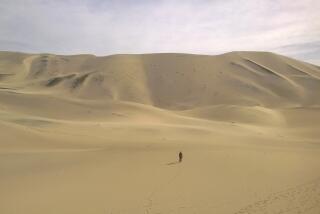Kilauea Volcano Putting on a Show on the Big Island
- Share via
VOLCANOES NATIONAL PARK, Hawaii — If you’ve never seen magma--and even if you have--there has rarely been a better view than the current one at Hawaii Volcanoes National Park.
The lava flow at the park’s Kilauea Volcano, which has been erupting since 1983 on the southeast side of the Big Island, has become more accessible to visitors in the last few weeks than it has been in seven years, rangers and geologists say. A short hike from a park road puts you within a few feet of molten rock. As many as 1,500 people a day make the trek, officials say.
The Mother’s Day Flow, named for the day on which it began, has created a lava delta that oozes and morphs less than a mile from the end of Chain of Craters Road. Using bright yellow flags and reflectors, park rangers mark the shifting footpath to the flow each day. They are on hand from about 10:30 a.m. to 10:30 p.m. along the trail to answer questions and keep visitors from tumbling in fissures and large cracks. Lava flow is unpredictable and can change course or stop at any time, geologists say.
The best time to visit is at night, when lava cascades down the mountainside like a stream of bright fire.
To avoid the crush, go after sunset when the crowds begin to thin and parking at the end of the road opens up. (At sunset cars sometimes have to park two miles from the trail head.) Sturdy shoes, long pants, water and a flashlight for night hikes are recommended. The trail’s surface is uneven, and falling on hardened lava can mean sharp cuts.
For eruption updates and cautions, visit www.nps.gov/havo or call (808) 985-6000. Park admission is $10 per vehicle.
More to Read
Sign up for The Wild
We’ll help you find the best places to hike, bike and run, as well as the perfect silent spots for meditation and yoga.
You may occasionally receive promotional content from the Los Angeles Times.






